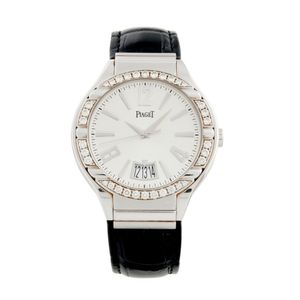Piaget Polo Grande Diamond-Set Wrist Watch with Date (2007)
Piaget polo grande Ref P10408 an 18ct white gold and diamond-set wrist watch with date circa 2007; dial: satine silvered, baton indexes, date aperture at 6; calibre: cal. 800P automatic winding, 25 jewels; case: brushed and polished round case, diamond-set bezel, hooded lugs, glazed display back secured by six screws diamond-set bezel; case number: 974526; closure: Piaget black leather strap and 18ct white gold folding clasp; dimensions: 43 mm diameter; signed: case, dial and movement; accessories: Piaget tax invoice dated 5 September 2022;
You must be a subscriber, and be logged in to view price and dealer details.
Subscribe Now to view actual auction price for this item
When you subscribe, you have the option of setting the currency in which to display prices to $Au, $US, $NZ or Stg.
This item has been sold, and the description, image and price are for reference purposes only.
- Movement - The technical name for the workings of a clock or watch, and does not include the dial or case.
- Circa - A Latin term meaning 'about', often used in the antique trade to give an approximate date for the piece, usually considered to be five years on either side of the circa year. Thus, circa 1900 means the piece was made about 1900, probably between 1895 and 1905. The expression is sometimes abbreviated to c.1900.
- Bezel - On a clock or watch, the bezel is the metal frame into which the watch or clock glass is fitted. In clocks, the bezel may include a hinge and a flange, in effect a door to the face of the clock. In jewellery the bezel is a band of metal with a projecting lip that holds the gemstone in its setting.
- Baton Numerals - A watch that instead of displaying numerals on the face, displays a marker in the form of a baton, or lower case letter "L". Since the baton-like marks are not numerals, the feature is also called baton markers, baton indexes and baton indicators.
- Date Aperture - A date aperture is a cut out section in the face of a watch or clock, displaying the day of the month.
This item has been included into following indexes:
